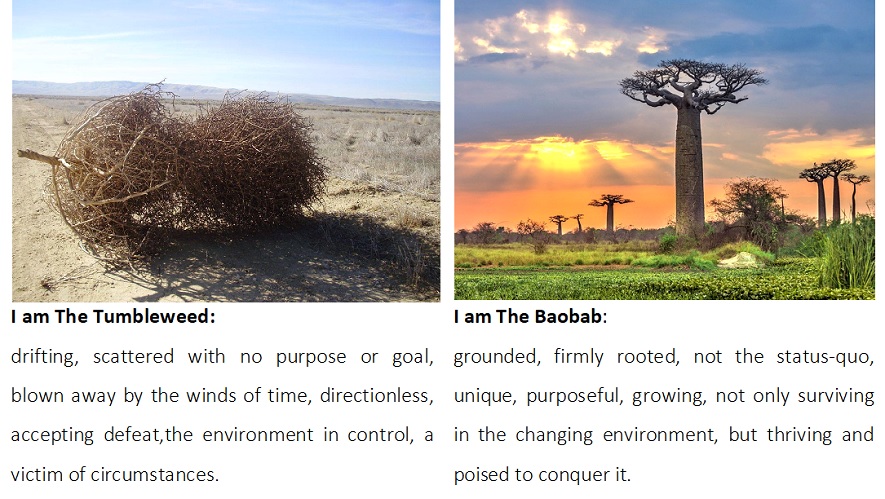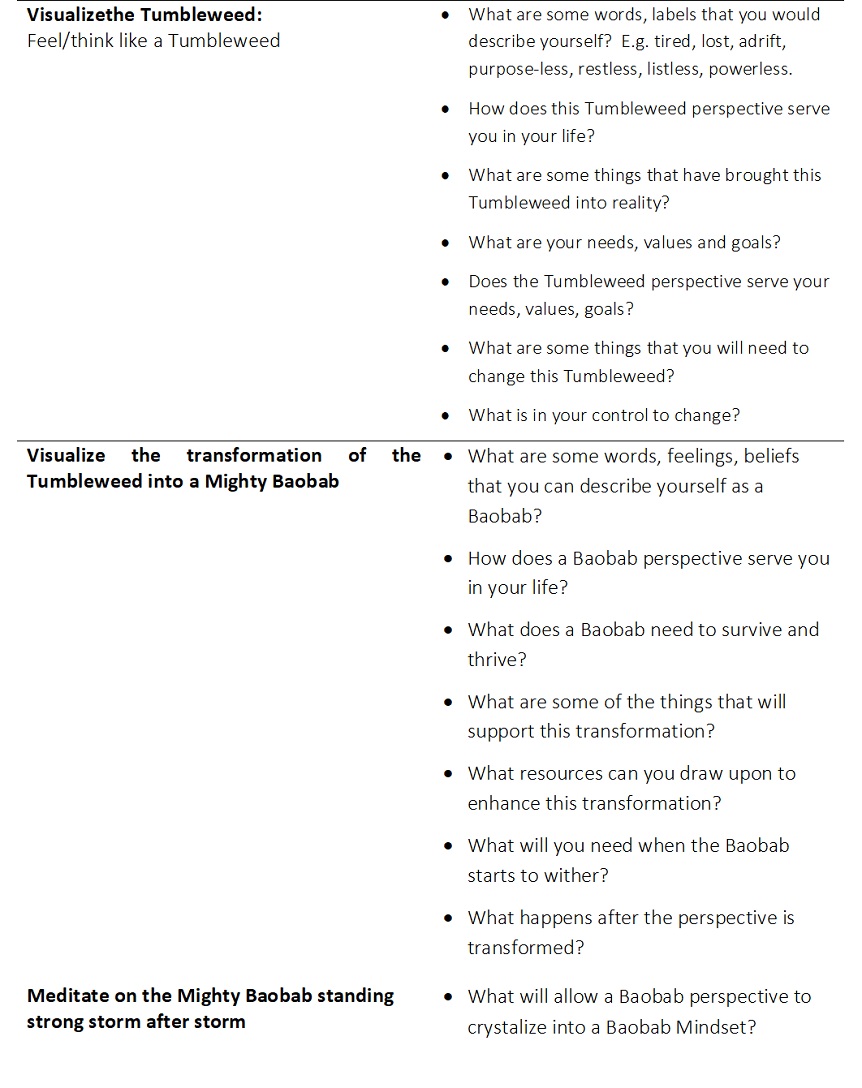 A Coaching Power Tool Created by Asheena Budhai-Manuel
A Coaching Power Tool Created by Asheena Budhai-Manuel
(Executive Coach, SOUTH AFRICA)
Introduction
This Power Tool explores the different perspectives that embody the concepts of:
The Tumbleweed vs The Baobab.

Explanation
The Changing Environment
Recently, we were dealing with understanding the parameters of the Fourth Industrial Revolution, how to exploit the digital economy, and facing major challenges in terms of digital workplaces, remote working, automation, and job losses.
The new decade of 2020 barely ushered in, when a pandemic was declared, and it has already had an indelible mark on humans. The Spanish Flu, HIV/AIDS, and now Covid19 have derailed humans and indicated the extent to which our comfort zones, stability, and fear of change can be tested. Charles Darwin, the author of Origin of Species, famously stated, “It is not the strongest of the species that survives, it is the one that is the most adaptable to change.”In 500 BC Greek philosopher, Heraclitus pointed out that“Life is flux,” and“there is nothing permanent except change,” as cited in Baker (2020). This Covid19 pandemic set a precedent in the 21st century. We are now experiencing sickness, death, health systems at the verge of collapse, economies eroded with job losses, companies closing down, government lockdowns and cracks deepening into crevasses.
The uncertainty that presents itself can often overcome mind, body, soul, leaving it lost, empty, listless, fatigued and defeated. Uncertainty is defined by Cleary and Malleret (2006: 15) as unmeasurable randomness with unknowable probabilities, which can be countered by managing the risk i.e. measuring uncertainty, characterizing it by some kind of measure of randomness, with knowable and thus calculable probabilities. In the Biblical story of Eve taking a bite of the apple in the Garden of Eden, the willingness to assume risk has undoubtedly propelled human progress. Interestingly, risk in the Chinese ideogram is represented by two symbols of threat and opportunity, and in the business world, executives anticipate change and manage it based on “an opinion of the future” (Cleary and Malleret, 2006: 14).
Baker (2020) cites psychotherapist Julie Samuel’s book, This Too Shall Pass Stories of Change, Crisis, and Hopeful Beginnings, “It’s the paradox that the more you allow yourself to accept that change is inevitable, the more likely you are to change intentionally and adapt.” Change can be an engine of progress (Baker, 2020). Success depends on awareness and having the ability to learn and the agility to adapt i.e. being resilient. This is the Baobab perspective of adapting and thriving.
Defining Resilience
Research has included various factors that create the characteristic of resilience in people. As explored on the MindTools website (2020), research by psychologists Susan Kobasa (1979), Martin Seligman(2006), and an interview with Cal Crow (2020) described some essential elements of resilience as:
- Challenge– Resilient people view difficulty as a challenge, not as a paralyzing event. They look at their failures and mistakes as lessons to be learned from, and growth opportunities. They don’t view them as negative reflections on their abilities or self-worth. They seem to reframe difficulties/obstacles as challenges to be overcome and learned from.
- Commitment– Resilient people are committed to their lives and their goals, and they have a compelling reason to get out of bed in the morning. Commitment is not restricted to their work – they commit to their relationships, their friendships, the causes they care about, and their religious or spiritual beliefs.
- Personal Control– Resilient people spend their time and energy focusing on situations and events that they have control over. They also feel empowered and confident since they put their efforts where they can have the most impact. Those that spend time worrying about uncontrollable events, whatever the future holds, can often feel lost, helpless, and powerless to act. This creates hopelessness and is disempowering.
- Permanence– People who are optimistic (and therefore have more resilience) see the effects of bad events as temporary rather than permanent.
- Pervasiveness– Resilient people don’t let setbacks or bad events affect other unrelated areas of their lives.
- Personalization– People who have resilience don’t blame themselves when bad events occur. Instead, they see other people, or the circumstances, as the cause.
- Resilient people have a positive image of the future. They maintain a positive outlook and envision brighter days ahead. Resilient people have solid goals, and a desire to achieve those goals.
- Resilient people are empathetic and compassionate; however, they do not waste time worrying about what others think of them. They maintain healthy relationships but don’t bow to peer pressure.
- Resilient people never think of themselves as victims – they focus their time and energy on changing the things that they have control over.
How we see adversity, failure, and stressful events in life strongly dictates if we will succeed which makes having a resilience mindset a superpower.
Reflection
The Tumbleweed vs The Baobab is not merely a reframing perspective change, but a reinforcing concept to anchor the mind in continual growth or as an iterative process to build resilience. The growth or iterative process is facilitated by the coach. The coach begins by uncovering the current situation of the client by asking questions about the present feelings, thoughts, beliefs, and direction.
Self-Application:

Table 1: Reframing Self Application
There will be some terms that will reveal a Tumbleweed perspective as tabulated above: I don’t know, I lack purpose, I don’t really know what I want, I am just tired, I am fatigued, I feel empty, I have no direction, I feel lost. Exploring the image of the Tumbleweed around present thoughts, feeling, beliefs, and habits allow mindful reflection. The shift in perspective begins with the visualization of being the Baobab tree. What could the Baobab tree represent? What would one like to feel and think: grounded, purposeful, growth mindset, building resilience. There is a need to develop the understanding that there is no quick fix in reframing a Tumbleweed to Baobab perspective, it is a slow, iterative process, but the challenge is the path of growth to thrive and prosper in mind, body, and soul. This rings true in as quoted by Louis Pasteur in 1854 that, “Chance favors the prepared mind.” Thus, using the Baobab perspective will allow a preparation of the mind to exploit whatever life has in store.
Coaching Application
The Personal Story
This can be used as a personal introspective exercise for the client, ideally not to be shared with the coach, but as a reflection exercise for the client. This exercise is an adaption from George and Sims (2007) True North: Discover Your Authentic Leadership. This is a starting point to reflect and formulate values and life purpose. The client is asked to use a blank page and given no rules on what to include or exclude, but only to identify significant events and factors that shaped the client. If there were parts of the life story that were difficult, reflect on the lessons that could be learned from them. Use the various events to create a pool of values.
The Values Tree
Another tool that could be used to develop a Baobab perspective is using the Value Tree. This was first proposed to be an effective starting point for decision-making (Keeney, 1996 cited in Keeney 2008). Symbolically the Baobab is a tree with roots deep in life experiences that give it nourishment, strength, encoded in its “value DNA” from its roots and extends through branches and its growth, purpose, and direction. Arguably, one of the greatest decisions is choosing your life’s journey. Thus, this perspective can be initiated by a Value Tree exploration (Teucsher and Anderson, 2013citing Anderson, 2002) by the client, which is an exercise that begins by pooling, then selecting a few core values that resonate strongly with the client. The pool can be values that come from the Self and Others (Teucsher and Anderson (2013) citing Anderson, 2002). This resonance is determined by many unique factors, for example, life experience, life philosophy, culture, nature, nurture, etc. The values tree is likened to a blank canvas to be painted in the lines and colors of the client’s life.
The client sees the holistic big picture of their lives and how they can draw power from within.
 Figure 1: Example of a Value Tree diagram and my own Values Tree Exercise (adapted from David Denborough, 2014 cited in Reekie (2020))
Figure 1: Example of a Value Tree diagram and my own Values Tree Exercise (adapted from David Denborough, 2014 cited in Reekie (2020))
When the Baobab comes to life for the client, the following opportunities arise:
Coaching Application: Building Resilience
The attraction of the Baobab perspective is the ability of the baobab to withstand every pressure of the environment, adapt, grow, survive, grow further, and thrive. The client wants to build resilience as a goal and commits to understanding, increasing awareness around resilience, and building a resilient mindset.
Conclusions
The power tool presented here focused on the metaphorical representation of two perspectives. The Tumbleweed i.e., purposeless, goalless, blown away by the winds of time, directionless, accepting defeat, the environment in control versus that of The Baobab, which is firmly grounded, growing, purposeful, surviving and thriving against all odds. The landscape of Life is filled with random and uncontrollable events, some positive and some negative. The ability to reframe adversity, mistakes, failure, stress and everything else life throws at human beings determines their success in life. One of the methods to do this is developing a resilient mindset, the epitome of the Mighty Baobab. Some elements of resilience were found to be: seeing difficulty as a challenge, being committed, having personal control, seeing events as not permanent, compartmentalize, they don’t blame themselves, they are empathetic and compassionate to others and themselves, they have a positive future outlook, goal-driven, and victimless.
The Coaching application of this tool is to facilitate the reflection process to reframe perspective to the positive and to anchor the mind in a continual growth or iterative process to build resilience. The coach begins by uncovering the current situation of the client using the Tumbleweed vs Baobab as a visualizer. The coaching process is to build resilience by inviting the client to introspect and compile their own personal story that shaped them to the current day and allow the client to connect with their values using the Values Tree exercise. Also, the client can choose to build resilience as their own goal to underpin their life goals, where the client creates their own action plan on how to build resilience sparked by a shift in Tumbleweed to Baobab perspective! The Baobab perspective will hopefully catalyze clients’ empowerment, growth, and success and ultimately reveal themselves as their own superpower!
Bibliography
Baker, L. (2020). Why Embracing Change is the Key to a Good Life, BBC.com [Electronic] Available: https://www.bbc.com/culture/article/20200930-why-embracing-change-is-the-key-to-a-good-life [October 13, 2020]
Blanchard, K., and O’Connor, M. 1997. Managing by Values, Better-Koehler Publishers, USA
Cleary, S. M., and Malleret. T. D. 2006. Resilience to Risk. Numan & Rousseau. A division of NB Publishers, Cape Town, South Africa
George, B., and Sims, P. 2007. True North: Discover Your Authentic Leadership. Jossey-Bass, USA
Keeney, R.L. 2008. Value-focused Thinking. Military Operations Research, 13, 2, [Electronic] Available: https://www.researchgate.net/publication/233717349[August 16,2020]
Reekie, J. 2020. WBS Leadership Coaching 2020 Notes. Wits Business School: Coaching Department: Johannesburg.
Teucsher, U.and Anderson, B. 2013. Coaching Tool: Creating a Values Tree. [Electronic] Available: www. https://www.researchgate.net/publication/257007001[August16, 2020]
MindToolsDeveloping Resilience- Bounce back from Setbacks. [Electronic]Available: https://www.mindtools.com/pages/article/resilience.htm [August 16, 2020]